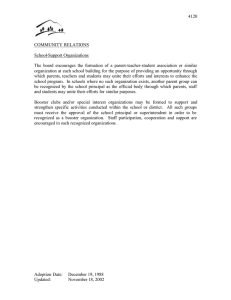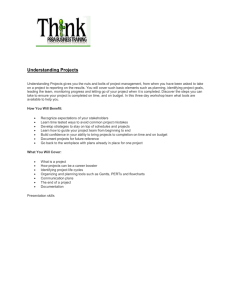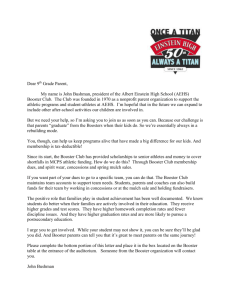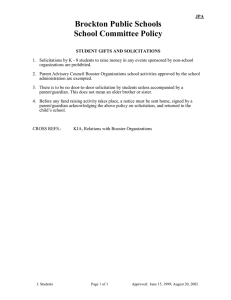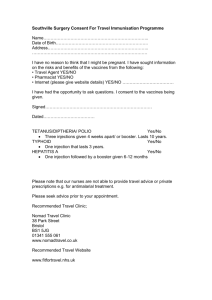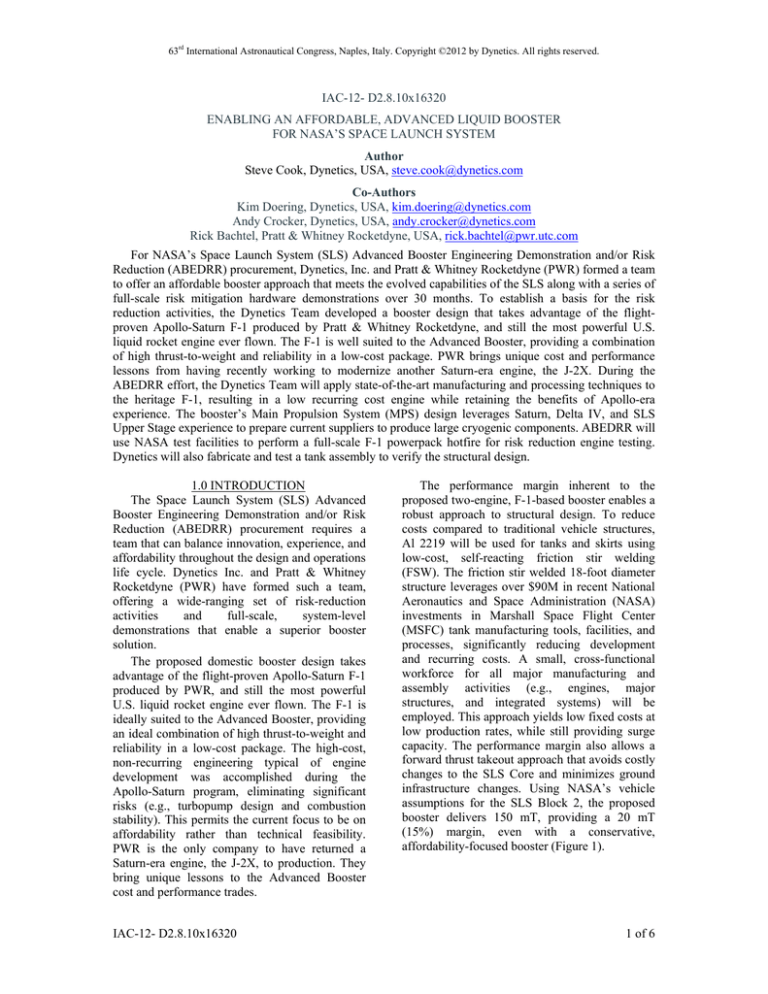
63rd International Astronautical Congress, Naples, Italy. Copyright ©2012 by Dynetics. All rights reserved.
IAC-12- D2.8.10x16320
ENABLING AN AFFORDABLE, ADVANCED LIQUID BOOSTER
FOR NASA’S SPACE LAUNCH SYSTEM
Author
Steve Cook, Dynetics, USA, steve.cook@dynetics.com
Co-Authors
Kim Doering, Dynetics, USA, kim.doering@dynetics.com
Andy Crocker, Dynetics, USA, andy.crocker@dynetics.com
Rick Bachtel, Pratt & Whitney Rocketdyne, USA, rick.bachtel@pwr.utc.com
For NASA’s Space Launch System (SLS) Advanced Booster Engineering Demonstration and/or Risk
Reduction (ABEDRR) procurement, Dynetics, Inc. and Pratt & Whitney Rocketdyne (PWR) formed a team
to offer an affordable booster approach that meets the evolved capabilities of the SLS along with a series of
full-scale risk mitigation hardware demonstrations over 30 months. To establish a basis for the risk
reduction activities, the Dynetics Team developed a booster design that takes advantage of the flightproven Apollo-Saturn F-1 produced by Pratt & Whitney Rocketdyne, and still the most powerful U.S.
liquid rocket engine ever flown. The F-1 is well suited to the Advanced Booster, providing a combination
of high thrust-to-weight and reliability in a low-cost package. PWR brings unique cost and performance
lessons from having recently working to modernize another Saturn-era engine, the J-2X. During the
ABEDRR effort, the Dynetics Team will apply state-of-the-art manufacturing and processing techniques to
the heritage F-1, resulting in a low recurring cost engine while retaining the benefits of Apollo-era
experience. The booster’s Main Propulsion System (MPS) design leverages Saturn, Delta IV, and SLS
Upper Stage experience to prepare current suppliers to produce large cryogenic components. ABEDRR will
use NASA test facilities to perform a full-scale F-1 powerpack hotfire for risk reduction engine testing.
Dynetics will also fabricate and test a tank assembly to verify the structural design.
1.0 INTRODUCTION
The Space Launch System (SLS) Advanced
Booster Engineering Demonstration and/or Risk
Reduction (ABEDRR) procurement requires a
team that can balance innovation, experience, and
affordability throughout the design and operations
life cycle. Dynetics Inc. and Pratt & Whitney
Rocketdyne (PWR) have formed such a team,
offering a wide-ranging set of risk-reduction
activities
and
full-scale,
system-level
demonstrations that enable a superior booster
solution.
The proposed domestic booster design takes
advantage of the flight-proven Apollo-Saturn F-1
produced by PWR, and still the most powerful
U.S. liquid rocket engine ever flown. The F-1 is
ideally suited to the Advanced Booster, providing
an ideal combination of high thrust-to-weight and
reliability in a low-cost package. The high-cost,
non-recurring engineering typical of engine
development was accomplished during the
Apollo-Saturn program, eliminating significant
risks (e.g., turbopump design and combustion
stability). This permits the current focus to be on
affordability rather than technical feasibility.
PWR is the only company to have returned a
Saturn-era engine, the J-2X, to production. They
bring unique lessons to the Advanced Booster
cost and performance trades.
IAC-12- D2.8.10x16320
The performance margin inherent to the
proposed two-engine, F-1-based booster enables a
robust approach to structural design. To reduce
costs compared to traditional vehicle structures,
Al 2219 will be used for tanks and skirts using
low-cost, self-reacting friction stir welding
(FSW). The friction stir welded 18-foot diameter
structure leverages over $90M in recent National
Aeronautics and Space Administration (NASA)
investments in Marshall Space Flight Center
(MSFC) tank manufacturing tools, facilities, and
processes, significantly reducing development
and recurring costs. A small, cross-functional
workforce for all major manufacturing and
assembly activities (e.g., engines, major
structures, and integrated systems) will be
employed. This approach yields low fixed costs at
low production rates, while still providing surge
capacity. The performance margin also allows a
forward thrust takeout approach that avoids costly
changes to the SLS Core and minimizes ground
infrastructure changes. Using NASA’s vehicle
assumptions for the SLS Block 2, the proposed
booster delivers 150 mT, providing a 20 mT
(15%) margin, even with a conservative,
affordability-focused booster (Figure 1).
1 of 6
63rd International Astronautical Congress, Naples, Italy. Copyright ©2012 by Dynetics. All rights reserved.
Fig. 1. The proposed booster exceeds performance requirements 20 mT over the 130 mT requirement.
The F-1 offers safety and reliability features
demonstrated on 13 Saturn V flights of 65
engines with no failures. As a liquid engine, the
F-1 can be acceptance tested to screen for defects
prior to integration and, with the vehicle
restrained, can be run on the pad for pre-launch
readiness demonstration. Finally, if an engine
does shut down, the booster can maintain vehicle
control by shutting an engine down on the
opposite booster, allowing either mission
completion or a safe crew escape, depending upon
the timing of the shutdown.
2.0 BOOSTER CONCEPT DESCRIPTION
The proposed booster features a robust
structural design paired with two F-1 engines,
evolved from the most powerful LOX/RP engines
ever flown. This combination of a simple, robust,
and manufacturable structure with reliable, highthrust engines provides confidence that NASA’s
affordability, reliability, and payload-to-orbit
requirements can be met. Figure 2 details design
features of the booster concept central to this
proposed affordable and reliable solution.
Figure 3 shows SLS vehicle performance for a
range of stage diameters against a number of
possible engine options explored during the
development of this booster configuration. The
18-foot diameter booster with F-1 engines was
selected to provide excess payload to orbit
capability while staying within the vehicle
dimensional requirements and mechanical
interfaces required by NASA. The booster
baseline design also reflects an effort to
emphasize commonality in interfaces and loads
between the SLS Core Stage and the Advanced
Booster configuration. This booster concept uses
a similar holddown and Core attach structure
while also yielding an acceleration and dynamic
pressure profile within NASA’s requirements.
Figure 3 also details the propellant mass fraction
of the booster against historical LOX/RP stage
designs, showing this booster concept as the most
robust liquid cryogenic stage ever built. The
proposed booster design with excess performance
provides mass and performance margin back to
the Core and Upper Stage in the Block 2
configuration.
Fig. 2. Overview of the Dynetics Booster Configuration
IAC-12- D2.8.10x16320
2 of 6
63rd International Astronautical Congress, Naples, Italy. Copyright ©2012 by Dynetics. All rights reserved.
Fig. 3. Performance of Dynetics Booster Versus Other Concepts.
To minimize structural and attach impacts to
the Core stage, Space Shuttle historical booster
loads were assumed with the application of a
conservative load factor. It is believed that this is
a conservative assumption, because many of the
load contributors inherent to solid rocket boosters
are eliminated or mitigated by liquid engine
boosters. Examples include thrust rise, thrust rate
mismatch at liftoff, thrust oscillation, and thrust
and mismatch at separation.
Although the focus of the booster design
activity concerned the Block 2 SLS configuration,
the performance of the booster concept for the
Block 1A SLS configuration (prior to
incorporation of the Upper Stage) has also been
assessed. For the Block 1A version of the booster,
a derated F-1 engine was baselined to provide
increased reliability by operating at reduced
chamber pressure and thrust while building flight
heritage for the SLS F-1 in preparation for Block
2. The SLS Block 1A configuration with the
proposed Advanced Booster provides payload
capability from 103 mT (F-1 derated to 85%) to
120 mT (100% F-1 power level).
Figure 4 presents a potential Advanced
Booster family of vehicles, which includes a
‘single-stick’ configuration, pairing the baseline
booster with an Ares I Upper Stage. This vehicle
yields 32 mT of payload to the SLS reference
orbit. This vehicle could be used for commercial
crew or satellite launches in the EELV-heavy
class.
IAC-12- D2.8.10x16320
The large thrust of the F-1 engines and a
robust structural design allow a family of vehicles
to be constructed around the proposed booster
concept, giving increased flexibility to mission
planners.
Fig. 4. Dynetics’ SLS Advanced Booster solution
provides a wide range of architectural
capabilities.
3 of 6
63rd International Astronautical Congress, Naples, Italy. Copyright ©2012 by Dynetics. All rights reserved.
3.0 ENGINE SYSTEM DESCRIPTION
The Dynetics Team identified a modernized
F-1 engine as the ideal Advanced Booster engine
concept because of the Saturn heritage engine
100% demonstrated flight reliability; high thrust;
and simple, low-pressure LOX/RP GG cycle. The
design features of the F-1 engine provide benefits
to enhance affordability, improve reliability, and
exceed payload performance requirements
(Figure 5).
The engine integrates the proven and critical
performance elements of the heritage F-1,
simplifications and performance enhancements
demonstrated on the F-1A, and modernized lowcost components such as a Hot-Isostatic Press
(HIP)-bond constructed channel wall Main
Combustion Chamber (MCC) and Channel Wall
Nozzle (CWN).
Fig. 5. SLS F-1 Engine Configuration
IAC-12- D2.8.10x16320
The GG cycle engine utilizes low system
pressures, which enable the use of low-cost
conventional material selections, such as
aluminum, throughout the engine primary flow
paths. This engine design eliminates two of the
highest cost performance-focused components—
the Turbine Exhaust Manifold (TEM) and nozzle
extension—and replaces the tube wall Thrust
Chamber Assembly (TCA) with the HIP-bonded
MCC and CWN. The resulting 1.8-Mlbf sea level
thrust engine delivers 150 mT payload, maintains
critical man-rated reliability/safety features,
integrates new higher reliability components, and
provides an affordable engine that supports the
schedule for Advanced Booster first flight on
SLS.
The F-1 engine design has continuous
throttling capability over a sea level thrust range
of 1.3 to 1.8 Mlbf to provide flexibility that
supports SLS program goals by enabling the
ability to tailor the thrust profile for each
individual SLS flight and configuration if desired
or required. SLS is envisioned to fly a diverse
range of missions (human, cargo, varying payload
mass, varying insertion orbits) using multiple
vehicle configurations (Upper Stage, no Upper
Stage, varying number of core engines) where the
ability to tailor the booster thrust profile provides
NASA great flexibility to achieve current and
future mission objectives.
4.0 MAIN PROPULSION SYSTEM
DESCRIPTION
The proposed Advanced Booster requires a
Main Propulsion System (MPS) that delivers
more than 10,000 pounds of propellant each
second of operation to a pair of F-1 engines.
Figure 6 shows the MPS configuration, features,
and benefits to NASA objectives. The propellant
feed system valves are based on recent engine
programs, such as RS-68 and J-2X. An active
Pogo suppression system built on Saturn MPS
lessons learned has been baselined, and engine
feedlines based on S-IC geometries and
components have been utilized. During flight, the
same autogeneous LOX tank and heterogeneous
gaseous Helium (GHe) RP tank repressurization
systems proven during the Saturn program will be
employed.
4 of 6
63rd International Astronautical Congress, Naples, Italy. Copyright ©2012 by Dynetics. All rights reserved.
Fig. 6. SLS Booster MPS Configuration
Fig. 7. SLS Booster Structural Configuration
Commonality and simplification are MPS
design goals to increase affordability and
reliability. The booster RP feedline is common to
the Core engine inlet; coupled with similar or less
total propellant, this allows common designs for
fill/drain, tank vent and relief, LOX thermal
conditioning, and pneumatic system components.
5.0 PROPELLANT TANKS AND
STRUCTURES
The methodology to design and manufacture
the booster tanks and associated structures
recognizes that affordability is essential to
providing an Advanced Booster for SLS. Highperformance
weight
considerations
drive
traditional designs, resulting in customized parts
and minimal commonality. The Dynetics Team
capitalizes on the performance margin provided
by the F-1 engine to produce a stout design with
70% fewer parts, 50% fewer linear feet of
welding, and a ‘leak before burst’ design for the
weld joints. Fewer parts, stronger parts, and less
welds result in reduced cost and higher reliability.
The all-aluminum 2219 configuration are
based on established designs and manufacturing
processes infused with state-of-the-art selfreacting Friction Stir Welding (FSW) joining
technologies and one-piece barrel technologies
from the commercial tanker industry. The large
18-foot diameter capitalizes on investments made
at NASA MSFC for the Ares I program. This
booster configuration features seven assemblies,
seen in Figure 7, each featuring a bolted joint to
permit simplified offline assembly.
Both tanks feature one-piece spun formed
domes with integral attachment chords and onepiece barrel sections, up to 11 feet long, produced
by state-of-the-art equipment. LOX tank Slosh
Baffles will be installed in the barrels prior to
tank welding. Tanks are then friction stir welded
with circumferential welds for the RP Tank and
LOX tank. Completing the structural arrangement
are manhole covers on the forward domes and
sump outlet fittings with baffles on the aft domes.
The manufacturing approach is to use
qualified suppliers to build major components
such as domes, chords, and thrust structures. The
tanks and associated structures will then be
assembled using self-reacting FSW equipment
located at NASA MSFC facilities. The cylindrical
sections will be welded on just two tools, shown
in Figure 8. Based on a limited build schedule, the
workforce across multiple programs will be
shared to ensure a low-cost manufacturing and
test process.
IAC-12- D2.8.10x16320
5 of 6
63rd International Astronautical Congress, Naples, Italy. Copyright ©2012 by Dynetics. All rights reserved.
Fig. 8. Cylindrical sections are produced using
FSW tools.
6.0 BOOSTER RISK REDUCTION
PROGRAM
The 30 month duration risk reduction plan
illustrated in Figure 9 reduces affordability risks,
allowing us to demonstrate that aggressive cost
targets can be achieved for the baseline booster.
State-of-the-art manufacturing and processing
techniques will be applied to the heritage F-1,
resulting in a low recurring cost engine, while
retaining the benefits of Apollo-era experience.
The Main Propulsion System (MPS) design
leverages Saturn, Delta IV, and SLS Upper Stage
experience to prepare current suppliers to produce
large cryogenic components. NASA test facilities
will be used to perform a full-scale powerpack
hotfire for low-cost risk-reduction engine testing.
A full-scale cryotank assembly will be fabricated
and tested to verify the structural design. Critical
avionics and operations demonstrations will be
conducted to reduce the cost risk of subsequent
full-scale integration. Finally, although the
expendable booster achieves commercial levels of
recurring cost, early engineering demonstrations
of stage recoverability and reusability is planned,
which could offer game-changing affordability
improvements. Over the next 30 months, the
Dynetics team will reduce the risk through a
series of full-scale risk mitigation hardware
demonstrations.
7.0 CONCLUSION
For NASA’s SLS ABEDRR procurement,
Dynetics, Inc. and Pratt & Whitney Rocketdyne
(PWR) formed a team to offer an affordable
booster approach that meets the evolved
capabilities of the SLS along with a series of fullscale risk mitigation hardware demonstrations. To
establish a basis for the risk reduction activities,
the Dynetics Team developed a booster design
that takes advantage of the flight-proven ApolloSaturn F-1 produced by PWR, and still the most
powerful U.S. liquid rocket engine ever flown.
The F-1 is well suited to the Advanced Booster,
providing a combination of high thrust-to-weight
and reliability in a low-cost package. PWR brings
unique cost and performance lessons from having
recently working to modernize another Saturn-era
engine, the J-2X.
Fig. 9. Risk reduction demonstrations summary.
IAC-12- D2.8.10x16320
6 of 6

